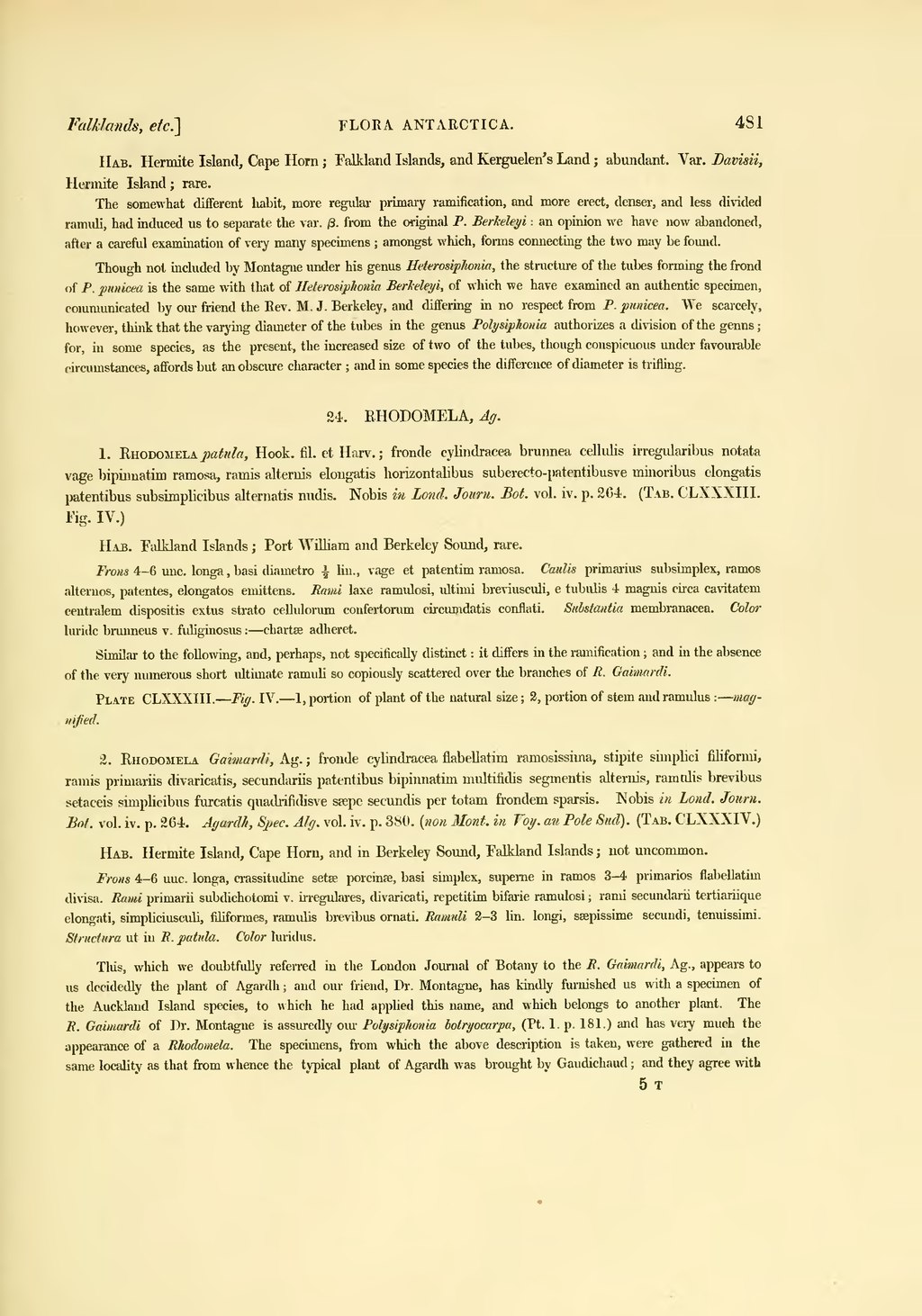Hab. Hermite Island, Cape Horn ; Falkland Islands, and Kerguelen's Land ; abundant. Var. Davisii, Hermite Island; rare.
The somewhat different habit, more regular primary ramification, and more erect, denser, and less divided ramuli, had induced us to separate the var. |3. from the original P. Berkeleyi -. an opinion we have now abandoned, after a careful examination of very many specimens; amongst which, forms connecting the two may be found.
Though not included by Montague under his genus Eeterosiphonia, the structure of the tubes forming the frond of P. punicea is the same with that of Eeterosiphonia BerMeyi, of which we have examined an authentic specimen, communicated by our friend the Rev. M. J. Berkeley, and differing in no respect from P. punicea. We scarcely, however, think that the varying diameter of the tubes in the genus Poly siphon ia authorizes a division of the genus; for, in some species, as the present, the increased size of two of the tubes, though conspicuous under favourable circumstances, affords but an obscure character ; and in some species the difference of diameter is trifling.
24. RHODOMELA, Ag.
1. Rhodomela ^;«fefo, Hook. fil. et Harv.; fronde cylindracea brunnea cellulis irregularibus notata vage bipinnatim ramosa, ramis alternis elongatis liorizontalibus suberecto-patentibusve minoribus elongatis patentibus subsimplicibus alternatis nudis. Nobis in Lond. Journ. Bot. vol. iv. p. 264. (Tab. CLXXXIII. Kg. IV.)
Hab. Falkland Islands ; Port William and Berkeley Sound, rare.
Frons 4-6 unc. longa , basi diametro i lin., vage et patentim ramosa. Caulis primarius subsimplex, ramos alternos, patentes, elongatos emittens. Rami laxe ramulosi, ultimi breviusculi, e tubulis 4 magnis circa cavitatern centralem dispositis extus strato cellulorum confertomm circumdatis conflati. Substantia membranacea. Color luride brunneus v. fuliginosus : — chartae adheret. Similar to the following, and, perhaps, not specifically distinct : it differs in the ramification ; and in the absence of the very numerous short ultimate ramuli so copiously scattered over the branches of R. Gaimardi.
Plate CLXXXIII. — Fig. TV. — 1, portion of plant of the natural size ; 2, portion of stem andramulus : — magnified.
2. Rhodomela Gaimardi, Ag. ; fronde cylindracea flabellatim ramosissima, stipite sirnplici filiformi, ramis primariis divaricatis, secundariis patentibus bipinnatim niultifldis segmentis alternis, ramnlis brevibus setaceis simplicibus furcatis qnadrifidisve saepe secundis per totam frondem sparsis. Nobis in Lond. Journ. Bot. vol. iv. p. 264. Agardh, Spec. Alg. vol. iv. p. 380. {rum Mont, in Toy. au Bole Sud). (Tab. CLXXXIV.)
Hab. Hermite Island, Cape Horn, and in Berkeley Sound, Falkland Islands ; not uncommon.
Frons 4-6 unc. longa, crassitudine seta? porcinse, basi simplex, superne in ramos 3-4 primarios flabellatim divisa. Rami primarii subdichotomi v. irregulares, divaricati, repetitim bifarie ramulosi ; rami secundarii tertiariique elongati, simpliciusculi, filiformes, ramulis brevibus ornati. Ramuli 2-3 lin. longi, ssepissime secundi, tenuissimi. Slructura ut in R. patula. Color luridus.
This, which we doubtfully referred in the London Journal of Botany to the R. Gaimardi, Ag., appears to us decidedly the plant of Agardh ; and our friend, Dr. Montagne, has kindly furnished us with a specimen of the Auckland Island species, to which he had applied this name, and which belongs to another plant. The R. Gaimardi of Dr. Montagne is assuredly our Polysiphonia botryocarpa, (Pt. 1. p. 181.) and has very much the appearance of a Rhodomela. The specimens, from which the above description is taken, were gathered in the same locality as that from whence the typical plant of Agardh was brought by Gaudichaud ; and they agree with
